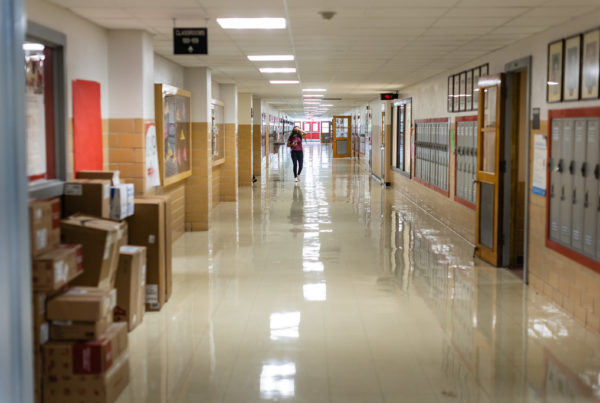Chivas Watson is a serial multitasker. So, a couple Thursdays ago when the community activist was taken off hold to testify by phone at an Austin City Council meeting, he was in the middle of something.
“One second,” he told council members. “Don’t start my time yet.”
Watson was driving down I-10 at the time. He was trying to get to a graduation at the University of Houston, but also tell his elected officials what he thought about their latest proposed budget. Watson was particularly concerned about the council’s decision to increase funding for the police department.
“Safety in Austin is not measured by more police patrols or oversight,” he told council members that day. When his one minute was up, a timer buzzed and his phone disconnected.
Since March 2020, Austinites have been able to dial into meetings, a capability typically prohibited by state law but allowed during the pandemic. On Wednesday, though, Gov. Greg Abbott allowed the suspended rule to go back into effect, including a provision requiring citizens to testify either in person or by videoconference.
As Austin is forced to return to in-person testimony, some people, including council members, are asking: If we cut the proverbial phone line, who or what do we lose?
“With in-person testimony being the standard again … the only people that probably will go down there to City Hall are the groups that generally experience more privilege,” Watson told KUT.
“[Mayor] Steve Adler told us about COVID best practices from a hotel in Barbados. If he can do that, then I should be able to jump into the queue from Timbuktu.”
It Was More Convenient
Last summer, Sarah Overton watched the outrage across the nation and in Austin as people protested racial injustice and called for police budgets to be shifted to other community services.
Overton, who identifies as mixed race, said it motivated her to testify before the Austin City Council for the first time.
“It was time-consuming,” she told KUT. “I probably sat on hold for about three hours. It could have been more.”
Overton, who works as a UX designer, was able to send emails from home while she waited. When her name was called, she told the council to put some of the police budget toward ambulances for the Austin-Travis County EMS.
“We need to invest in more ambulances,” she told the council. “We’re in the middle of a global pandemic.”
If she had been required to testify in person, Overton said, she probably would have stayed silent.
“Having to go downtown, having to find parking, having to carve time out of my day … that’s more time than I have to take away from my day,” she said. “The city’s losing the voices they really should be listening to and they want to hear from. They’re making it more difficult and less accessible for those people.”
It’s hard to deny the convenience of picking up the phone to tell local government officials what you think versus having to travel to City Hall. And while the number of people who signed up to speak to City Council in 2020 increased over the year before, it’s unclear if convenience, or the events of the last year, was the prime motivator.
According to numbers from the City Clerk’s Office, almost 2,000 more people testified at regularly scheduled council meetings last year than in 2019. But just one meeting could be responsible for this jump: More than 2,000 people signed up to testify last July about how Austin police responded to protests that summer.
“Obviously there were a lot of benefits of having things over the phone,” Gordon Abner, an assistant professor at UT Austin’s LBJ School of Public Affairs, said.
“At the same rate, it didn’t necessarily fix issues in terms of how many people are aware of public participation or cynicism in government,” he said. “While I don’t think being forced to go back to in-person commenting is a good thing, it’s also important to think about the fact that being able to comment over the phone wasn’t necessarily a panacea either.”
Some People Felt Safer
While Austin keeps count of the number of people who sign up to speak, it does not ask for demographic information from these people — although there is some evidence government meetings in Austin typically are dominated by white residents.
But Council Member Greg Casar wagers that opening a phone line to City Hall brought out a more diverse population.
“I think we got a much broader swatch of who Austin really is when people were able to call in by phone,” he said. “There were a lot more Spanish speakers and immigrant families calling in.”
Meetings last summer often began with at least 20 minutes of testimony in Spanish, with someone translating into English so the majority of council members could understand. At those meetings, the council considered whether to approve millions in assistance for people affected financially by the pandemic.
“My husband and I were suspended from our jobs,” one woman told council members in Spanish. “We are not working right now and we are a family of eight.”
But at least once, the city was caught flat-footed, and council had to ask Alicia Torres, a local organizer who happens to be bilingual, to translate — even though she is not a professional interpreter.
Torres, who works for Grassroots Leadership, told KUT she was happy to do it. As the city returns to in-person testimony, she said she worries non-English speakers and immigrants will not only be locked out of participating because of the time or cost of getting to City Hall, but also because entering a government building can feel risky to some.
“As someone who is undocumented, it feels intimidating when you’re going to go up, especially during some testimony, and you know that there’s going to be heavy police presence there,” Torres said. “You don’t know if after you leave that meeting, is the police going to follow you? Is you offering up your testimony going to have ramifications afterwards?”
When you feel safe, Carmen Llanes Pulido said, you’re not only willing to show up but you’re also able to testify more honestly.
“People are able to bring their whole selves in when they’re able to speak from where they are,” Llanes Pulido, executive director of Go Austin Vamos Austin, said. “It paints a picture of the lives that people are living and the experience that’s informing their testimony.”
Llanes Pulido said she recalls one woman who testified to a government committee via videoconference from her kitchen.
“[I] was watching a Spanish-speaking mother and head of household participating in a public meeting with city officials, and she was standing over a large soup pot making dinner for obviously a lot of people,” Llanes Pulido said. “Her teenage son was muting and unmuting for her with the phone propped up and she was going about her business and able to speak so clearly and pragmatically to the issue.”
She said she’s not sure how this woman’s testimony would have changed had she spoken within the sterile walls of City Hall chambers.
And then there’s the obvious health concern of having to stand in an enclosed room with other people in order to testify. While the number of COVID-19 cases has begun to plateau, the Austin area recently set a record for the number of people hospitalized with the disease.
And that has David King, who frequently testifies at City Hall, reconsidering how he’ll give feedback to council members.
“I’m 65 now and I happen to be a cancer survivor,” King said. Even though he’s vaccinated against COVID-19, he has a higher risk of getting sick if he contracts the virus. “Being exposed to these variants that are so deadly [worries me]. That is going to weigh on the amount of time I participate in person.”

The city says it takes more staff members to handle remote public testimony than it does for in-person testimony. Photo: Gabriel C. Pérez
What Happens Next?
Save a change to state law, it’s unclear whether phone testimony will return to Austin City Council meetings. The city is looking into setting up videoconferencing from select public libraries.
At a meeting Tuesday, City Clerk Jannette Goodall reminded council members of the resources testifying virtually requires. She said two people are required to staff an in-person meeting, but five staff members are needed when the council meets virtually because of the preparation and technology required.
“Virtual meetings are much more labor intensive,” she said.
Nonetheless, several council members said they saw the merits of phone testimony — even if reinstating it means lobbying for a change to state law.
“When we set up a situation that people can only participate in person, we’re excluding part of our population and we’re putting them in a position where they have to choose between their individual circumstances and their own health or their family’s and their ability to talk to us,” Council Member Ann Kitchen said.
“I think we should do everything within our abilities and within the law to allow options options for people to participate virtually.”
Got a tip? Email Audrey McGlinchy at audrey@kut.org. Follow her on Twitter @AKMcGlinchy.














